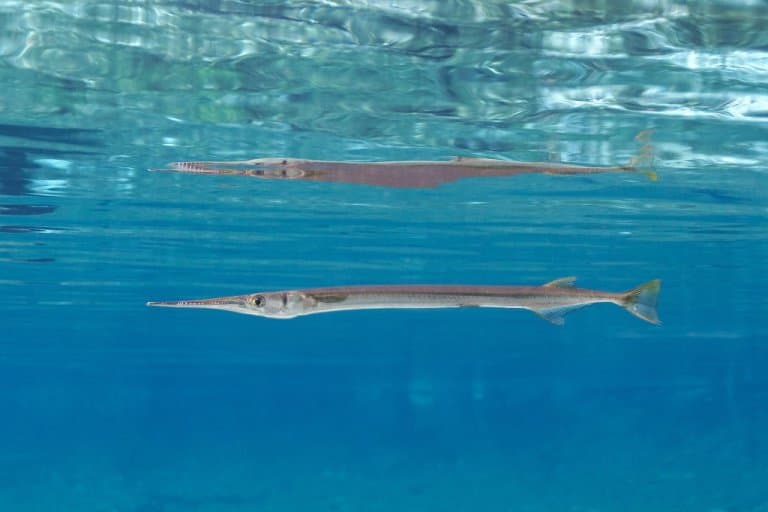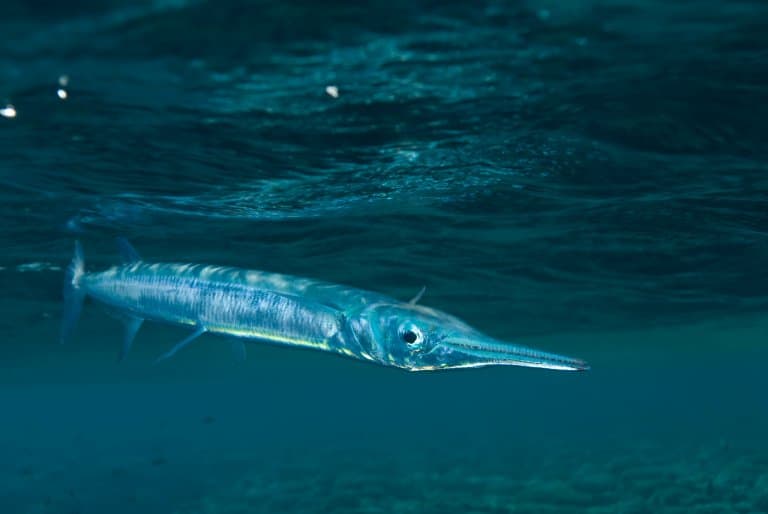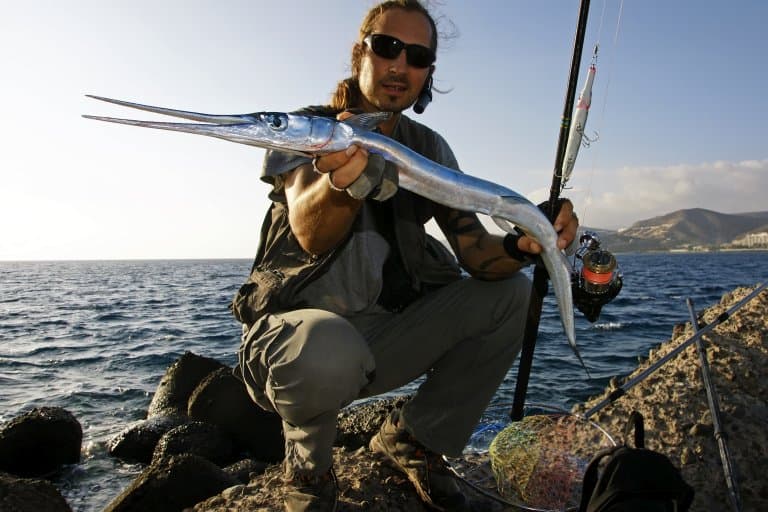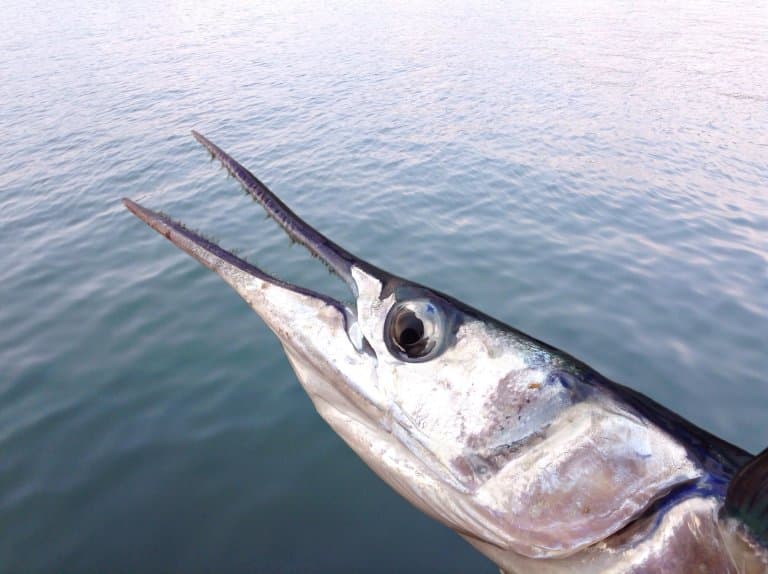Needlefish Profile
Needlefish, also known as long toms, are all the fish in the family Belonidae. These are unique looking fish with long “beaks”. They can come in a variety of shapes and sizes, but this is one feature that always seems to stay the same!
The fish in the family Belonidae are known as piscivorous fish. This means that their diet is mainly made up of other type of fish.
Their name derives from their jaws containing numerous needle sharp teeth.

Needlefish Facts Overview
| Habitat: | Shallow marine, brackish, and freshwater habitats, as well as the surface of the ocean |
| Location: | Most places except for Antarctica and the Arctic |
| Lifespan: | Up to 8 years |
| Size: | 3 to 95 cms long |
| Weight: | Up to 4.5 kg |
| Color: | Silver, blue, grey |
| Diet: | Smaller fish, krill, crustaceans, and insects |
| Predators: | Larger fish, dolphins, and birds |
| Top Speed: | 60 kph (37 mph) |
| No. of Species: |
60 |
| Conservation Status: |
Least concern |
Because there are so many different species of needlefish (around 60, to be exact), they can be found in many places around the world. This includes most of the major oceans and seas and they are most common in tropical and warm waters.
Needlefish prefer shallow waters, such as marine habitats, or the surface of open ocean waters. In the wild they live in social groups of fish known as schools, and will migrate to find food sources and temperate water.
They vary in size depending on species and measure between 3 to 95 cm (1.2 to 37.4 in) in length with thin, elongated bodies. They have a distinctive, long narrow beak with extremely sharp teeth.
Needlefish are ambush predators that can attack with speed and precision, and diet primarily on smaller fish. Some species will also eat krill, crustaceans and insects.
Since needlefish swim near the surface at high speed, they are known to try and leap out of the water over the decks of small boats, rather than swim around them.
They are considered gamefish and are caught by fisherman. They are also a popular fish in Central and South America and the Caribbean.
Interesting Needlefish Facts
1. They use Snell’s Window to hunt
Before understanding just how needlefish use Snell’s Window, it’s important to understand just what Snell’s Window is.
Also known as Snell’s circle or optical man-hole, Snell’s Window is a phenomenon that occurs with light and water. It deals with how everything above water looks from underneath. Let’s say you were to dive deep into the water. If you were to look up, you’d only be able to see a small circle of the sky above. Everything outside of that circle would either be complete darkness or a reflection of underwater. This can make it difficult to tell exactly where things underwater are.
Needlefish are able to use this to their advantage. They have evolved to lunge at certain angles towards school of fish. Because of the way light reflected and refracts underwater, the school of fish can’t see the needlefish coming properly, allowing the predator to get in close and secure dinner. 1

2. Attacks on humans have been serious – and even lethal!
It’s not just fish that the needlefish pose a threat towards. Although a needlefish won’t set out with the intentions of harming a human, it can, and quite often does, happen.
You see, needlefish have a habitat of leaping out of the water at top speeds, usually to escape predators. When this happens, their sharp beak can make them a dangerous projectile.
Articificial light at night also attracts needlefish, and night fisherman in the Pacific Ocean have reported being “attacked” by schools of needlefish jumping onto their boats.
The resut is several injuries and deaths throughout the years. The most recent event to date was in 2018, when a 22 year old Thai Navy trainee Kriangsak Pengpanich was struck in the neck by a needlefish moving at high speed. 2
3. Some species can be kept in advanced aquariums
Although they can be dangerous, needlefish can actually be kept in an aquarium.
Since there are so many species, it’s important to pick one that can survive in captivity. This typically involves one of the smaller species that can tolerate different water conditions.
It’s also important to ensure that you have enough skill, experience, and resources available before trying to raise needlefish.
4. They live in freshwater and saltwater
Other than the fact that there are so many different species, one of the reasons that you can find needlefish almost everywhere is due to the fact they can live in freshwater or saltwater.
You can find them from seas to oceans to rivers and streams.
5. Needlefish can swim up to 60 kph (37 mph)
As mentioned earlier, needlefish have the ability to lunge out of the water, much like a dolphin or shark. This is why they can pose a danger to humans who may be engaging in water recreation.
This is also in part due to the top speeds they can reach while doing so. A needlefish jumping out of the water can easily reach speeds up to 60 kilometers per hour!

6. They look similar to gars
Thanks to their long beak, the needlefish actually looks quite similar to gars. Some species may even be known as gars or garfish! However, the needlefish and true gar are only distantly related.
7. Their name comes from Greek
When you look to scientific names, it can seem like they’re fairly random. However, as the needlefish shows, there’s actually some connection between and animal and their name.
All needlefish are in the family Belonidae. Belone, the root of Belonidae, is actually a Greek word, which means “needle”.
8. Different species of needlefish can be found throughout the world
There are over 60 different species of needlefish. Each one can look different from another, with some species so unique you wouldn’t even know they were a needlefish!
They can be found in various places around the world, with these location differences playing a large role in the size and appearance of a species.

9. Needlefish don’t have a stomach
All needlefish species completely lack a stomach. Somewhere along their evolutionary ‘path’, their stomach was lost.
They swallow their prey whole and digest it – without a stomach. Instead of a stomach with acid to break down food, they uses an enzyme called ‘trypsin’ that can break down proteins instead.
While researchers believe this is less efficient than a stomach, it might be an energy-saving solution, as stomachs can be a fairly expensive organ to keep running. 3
10. They engage in mutualistic relationships with other fish and sea life
Although they may be a predator, needlefish actually thrive in the underwater communities of the world. They’ve been known to form mutualisitc relationships with other animals. One of the most notable is with the cleaner wrasse.
The cleaner wrasse helps clean parasites and other materials from the needlefish, which as a result keeps the needlefish healthy and gives the cleaner wrasse a quick meal!
Needlefish Fact-File Summary
Scientific Classification
| Kingdom: | Animalia |
| Phylum: | Chordata |
| Class: | Actinopterygii |
| Order: | Beloniformes |
| Family: | Belonidae |
| Genera: | Ablennes Belone Belonion Petalichthys Platybelone Potamorrhaphis Pseudotylosurus Strongylura Tylosurus Xenentodon |
Fact Sources & References
- David K. Lynch and Simon Higton (2014), “Snell’s Window“, Universities Space Research Association.
- Thaiger (2018), “Freak needle-fish accident kills Thai Navy cadet“, Thaiger.
- Michael Marshall (2011), “Zoologger: The fish with no stomach for its prey“, New Scientist.
